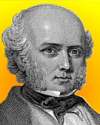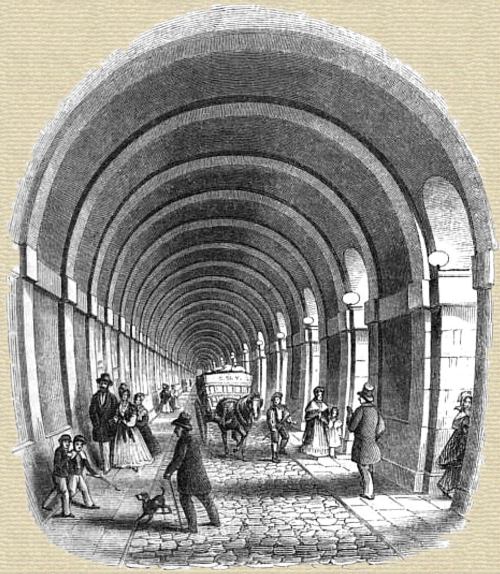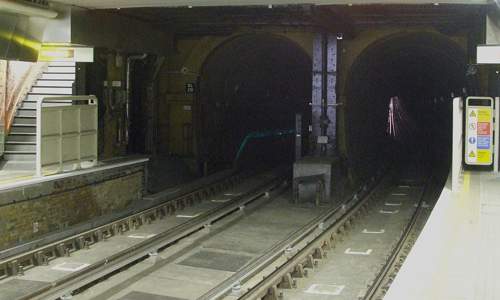 (source)
(source)
|
David W. Bartlett
(16 Apr 1828 - 25 Jun 1912)
American traveller and writer whose books include What I saw in London, Life of Lady Jane Grey, Paris with Pen and Pencil, and Pen-Portraits of Modern Agitators. For twenty years he was the Washington correspondent of the New York Independent, Springfield Republican, and New York Evening Post.
|
A Visit to the Thames Tunnel
from What I Saw in London (1853)
by David W. Bartlett
[Bartlett based this book on two separate stays in London, each of one year duration. He made his first trip at age 19, sailing from Boston to Liverpool in autumn 1847, and the second, in July 1850, sailing from New York for Liverpool. On arrival, he travelled by train to London, a journey which impressed him with the solidity of the construction of the English railway track, bridges and tunnels.]

[The artist's impression is fanciful: there was no horse traffic, and the people are drawn too small.]
[p.163] With a friend, one day the last summer, we visited the Thames Tunnel, and though it was not our first visit, by any means, yet we were awed by the grandeur of the marvellous structure.
From the Bank we turned east into Bishopsgate, then into a Jew street called Houndsditch, and soon entered Whitechapel. Here, at a junction of streets, we saw the famous establishment of “E. Moses and Son,” the great clothing-dealers of London. The building is costly and showy, but is, like all such gaudy shops, wanting in taste. We soon came in [p.164] sight of the Tower, with its turrets gilded by the morning’s sun, and passed down towards Wapping, one of the dirtiest places in London. It is full of low houses, ignorant people, obnoxious scents. The inhabitants are many of them coal-heavers, and are wretchedly poor. But soon we saw a humble guide-board with “To the Tunnel” inscribed upon it, and turning to the right, saw before us the little circular tower of stone which guards the shaft from the occasional overflow of the water in the Thames.
As we entered the door, each slipped the “toll—one penny —upon a counter, and passed through a gate which would only admit one person at a time, and which, at the close of the day, indicates the number of persons that have passed through it, thus giving the servants in attendance no opportunity to cheat, were they so disposed. When we had passed this clicking gate, we entered the circular room which is at the top of the shaft of the Tunnel, on the Wapping side of the Thames. Leaning over the rail, we looked far, far below upon the floor of the Tunnel, and saw spectators looking away across to the Rotherhithe side of the river. In the little room, upon its walls, there are a few daubs of paintings, of Naples, and other beautiful places in the world. Gladly leaving these, we commenced our descent by the spiral staircase. At last we were upon the bottom. Gas-lights were burning brightly, for it is always night in this subterranean region. We found that it was impossible to see to the opposite end of the tunnel, either from a curvature, or because of the distance, which is 1200 feet. The noise of music was in our ears, and in the many arches of the Tunnel, it sounded prettily. The Tunnel has two divisions, or half-arches— through one it was intended that carriages should pass, and through the other, foot-passengers. Between the two departments, there are innumerable little Cross-arches, which were lit up, and occupied by old women and young women, with.[p.165] all kinds of gewgaws, and fine baubles, for sale. There was note-paper, with pictures of the Tunnel upon it, all manner of views, and trinkets, and edibles, which were pressed upon us with that zeal which European shopmen know so well how to exercise.
In the centre there was a “Steam Cosmorama,” turning out views “beautiful and unique,” for “only one penny!” It was patronized too, once, by Her Majesty the Queen, which of course wreathed the brow of the proprietor in unfading laurels! Once upon a time, the Queen, attended only by one or two ladies, came here in great haste, and as soon as she had entered, no one was allowed to pass in until she had come out. The keepers of the stalls, the old and young women, were overwhelmed with the visit, so unexpected, so glorious, and with an impulse of truest loyalty, made a path for the blooming Queen with their handkerchiefs and their shawls! Then to think what a sight the few who were in the Tunnel had of Her Majesty! And the Queen out of curiosity entered the little “Steam Cosmorama,” for one penny, and ever since, the word “ Royal” has been prefixed to it!
Standing in the middle of the Tunnel, we could see each entrance with distinctness. There was a little coffee-room close by us, and with our companion we took a seat and called for a cup of the beverage and a couple of “ hot cross-buns,” merely to gratify a fancy, for we were not hungry.
There were many gentlemen and ladies present while we were in the Tunnel, mere visitors, and occasionally some person on business crossed from one side to the other. However, as a thoroughfare and speculation, it is a great failure, paying scarcely interest upon the capital emphatically sunk in the construction of the Tunnel. The carriage-way has never been completed at the entrances, as it is sure not to pay for the immense outlay of money necessary to construct a gradual approach to the level of the Tunnel.
[p.166] We passed along to the Rotherhithe entrance, where a woman wished to take our likenesses for only a shilling, and an Italian music-grinder gave us his coarse-ground melodies for what we pleased to give in return. Then we sauntered slowly back towards the Wapping side, thinking as we walked of the daring spirit of the man who first proposed to construct this mighty Tunnel, and who accomplished, after years of difficulty, what he undertook. Isamburt Brunel was that man—afterwards Sir I. Brunel, as a reward for his genius, his courage and perseverance, and final success.
In 1824, by express act of Parliament, after the continued suit of Mr. Brunel, a company was formed to construct the Tunnel, and in March, 1825, the workmen commenced sinking the shaft. Day after day it descended, until at last it rested upon the proper level, and the main work commenced. The excavation was to be about 38 feet broad and 22 high, but it never could have been done but for the invention of a shield by Mr. Brunel, in which the workmen could pursue their work with comparative safety. The first few feet of excavation was through a firm clay, and then came a loose and watery sand, and for thirty-two days did the workmen dig ahead in this soil, expecting death every day, until hard ground was again reached.
On the 14th of March, 1826, bursts of water came through upon the workmen, but the precautions taken were so good that the shield was closed against it, and no one was harmed. Two weeks after, a similar occurrence took place. The 1st of January, 1827, 300 feet of the Tunnel were completed, but as depressions in the bottom of the river were discovered bags of clay were thrown in to fill it up to the usual level.
In May, a great irruption took place while all the workmen were at their posts. The water came pouring in, in volumes upon them, and they ran for their lives. Some were knocked [p.166] down, while others were choking with water. One of the assistant engineers says:
“The wave rolled onward and onward. The men retreated and I followed. Then I met Isamburt Brunel. We turned round: the effect was splendid beyond description. The water as it rose became more and more vivid—as we reached the staircase, a crash was heard, and then a rush of air extinguished all the lights. … I looked up and saw the staircase crowded—below, and beheld the overwhelming wave. Dreading the reaction of this wave upon our staircase, I exclaimed, ‘The staircase will blow up!’ Mr. Brunel ordered the men to get up with all expedition, and our feet were scarcely off the bottom stairs, when the first flight which we had just left, was swept away. … The roll was immediately called—not one absent!”
It took a long time to fill up this chasm with clay, and go to work again at the Tunnel, but the genius of Brunel would not rest. It is said that the workmen became accustomed to expect death at any instant, and that one night at dead midnight, while a son of Mr. Brunel was overseeing the workmen, he heard a cry of “The water! The water!” and hurrying to the place of danger, found the poor exhausted laborers fast asleep in the “shield”—one of them had cried out in his dreams!
In 1828, another irruption took place, and this one was fatal to many lives. A son of Mr. Brunel was at the time in the Tunnel, and was knocked down. He struggled under the water for awhile, his knee was badly injured, and he set out to swim to the entrance, when a mighty wave came sweeping along, which swept him on, and on, and finally up to the top of the shaft, where he was saved. But many of the poor workmen were killed or drowned. This calamity occurred at an unfortunate crisis. The funds of the company were low, and they ceased operations. Mr. Brunel was in a [p.167] state bordering on madness, but for seven years his favorite work was untouched. Yet it is said that every day of that seven long years, he came and viewed with a melancholy brow the half-wrought Tunnel, and would not give up his hopes. See what “Nil desperandum” accomplishes! In 1835, after a respite of seven years, the arches of the Tunnel were unclosed, and laborers went to work at it under the old master-genius, Isamburt Brunel. Five different irruptions took place, but the work went steadily onward until on the morning of the 13th of August, 1841, Mr. Brunel—now Sir I. Brunel—passed under the Thames, completely to the other side. His great thought was at last turned into reality—he had made a pathway for millions under a river which carries upon its bosom the fleets of all nations of the world!
The whole cost was in the region of $3,000,000, but as we have remarked, it does not pay as a pecuniary scheme. Still, it stands before the world as the mightiest work of its kind in all the world—and it is well worth three millions! Perhaps there was never a brighter instance of Genius struggling under the most disheartening difficulties, and finally, through every obstacle, achieving not only a glorious success, but an appreciation of it from the highest quarters. Well did Isamburt Brunel deserve the honors he received—without them his name would be immortal.
It is a strange feeling which comes over one as he stands in the centre of the Tunnel, and knows that a mighty river is rolling on over his head, and that great ships with their thousands of tons burthen, sail over him. We well remember our first visit to the Tunnel, and how our companion, an English lady of lively temperament, said as we stood in the centre:
“Ah! what if now these arches were to give way, or the river were to gush in upon us, what would become of u?”
The bare idea of such a thing was enough to strike one with horror.
[p.169] “But,” added she, “I am your cicerone to-day, so we will sit down, and while tatting some marmalade, compute the possibility of the thing!”
Preposterous as it may seem, there are people in London who durst not venture into the Tunnel!
There is no single work of Art in London (with the exception of St. Paul’s Cathedral) which excites so much curiosity and admiration among foreigners as the Tunnel. Great buildings are common to all parts of Europe, hut the world has not such another Tunnel as this. There is something grand in the idea of walking under a broad river—making a pathway dry and secure beneath ships and navies!
- Science Quotes by David W. Bartlett.
- 25 March - short biography, births, deaths and events on date of the Thames Tunnel opening to pedestrians.





